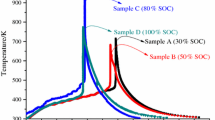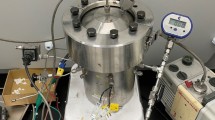Abstract
Vent sizing package 2 (VSP2) was used to measure the thermal hazard and runaway characteristics of 18650 lithium-ion batteries, which were manufactured by Sanyo Electric Co., Ltd. Runaway reaction behaviors of these batteries were obtained: 50% state of charge (SOC), and 100% SOC. The tests evaluated the thermal hazard characteristics, such as initial exothermic temperature (T 0), self-heating rate (dT dt −1), pressure-rise rate (dP dt −1), pressure temperature profiles, maximum temperature, and pressure which were observed by adiabatic calorimetric methodology via VSP2 using customized test cells. The safety assessment of lithium-ion cells proved to be an important subject. The maximum self-heating rate (dT dt −1)max and the largest pressure-rise rate (dP dt −1)max of Sanyo 18650 lithium-ion battery of 100% SOC were measured to be 37,468.8 °C min−1 and 10,845.6 psi min−1, respectively, and the maximum temperature was 733.1 °C. Therefore, a runaway reaction is extremely serious when a lithium-ion battery is exothermic at 100% SOC. This result also demonstrated that the thermal VSP2 is an alternative method of thermal hazard assessment for battery safety research. Finally, self-reactive ratings on thermal hazards of 18650 lithium-ion batteries were studied and elucidated to a deeper extent.





Similar content being viewed by others
Abbreviations
- T 0 :
-
Initial exothermic temperature (°C)
- dT dt −1 :
-
Self-heating rate (°C min−1)
- dP dt −1 :
-
Pressure-rise rate (psi min−1)
- △T ad :
-
Adiabatic temperature rise (oC)
- △P ad :
-
Adiabatic pressure-rise (psig)
- P max :
-
Reaction maximum pressure (psig)
- T max :
-
Reaction maximum temperature (oC)
- △H :
-
Heat of reaction (J, kJ)
- W:
-
Power (J s−1, kJ s−1)
- C total :
-
Total specific heat capacity (J g−1 K−1)
- C can :
-
Specific heat of the 18650 stainless steel can (J g−1 K−1)
- C cell :
-
Specific heat of the materials of the lithium-ion batteries (J g−1 K−1)
- m total :
-
Total mass of the 18650 lithium-ion (g)
- m can :
-
Mass of the 18650 stainless steel can (g)
- m cell :
-
Mass of the materials of the lithium-ion batteries (g)
- M f :
-
Mass of the lithium-ion batteries after experiment (g)
References
Sato N. Thermal behavior analysis of lithium batterier for electric and hybrid vehicles. J Power Sources. 2001;99:70–7.
Levy SC. Safety reliability considerations for lithium batteries. J Power Sources. 1997;68:75–7.
Tobishima S, Takei K, Sakurai Y, Yamaki J. Lithium ion cell safety. J Power Sources. 2000;90:188–95.
Zhang Z, Fouchard D, Rea JR. Differential scanning calorimetry material studies: implications for the safety of lithium-ion cells. J Power Sources. 1998;70:16–20.
Tobishima S, Yamaki J. A consideration of lithium cell safety. J Power Sources. 1999;81–2:882–6.
Al Hallaj S, Maleki H, Hong JS, Selman JR. Thermal modeling and design considerations of lithium-ion batteries. J Power Sources. 1999;83:1–8.
Maleki H, Howard JN. Internal short circuit in Li-ion cells. J Power Sources. 2009;191:568–74.
Roth EP, Doughty DH. Thermal abuse performance of high-power 18650 Li-ion cells. J Power Sources. 2004;128:308–18.
Veluchamy A, Doha CH, Kima DH, Lee JH, Shina HM, Jin BS, Kima HS, Moon SI. Thermal analysis of LixCoO2 cathode material of lithium ion battery. J Power Sources. 2009;189:855–8.
Chen G, Richardson TJ. Thermal instability of Olivine-type LiMnPO4 cathodes. J Power Sources. 2010;195:1221–4.
Biensan P, Simon B, Peres JP, Guibert A, Broussely M, Bodet JM. On safety of lithium-ion cells. J Power Sources. 1999;81–2:906–12.
Chi JH, Wu SH, Shu CM. Thermal explosion analysis of methyl ethyl ketone peroxide by non-isothermal and isothermal calorimetric applications. J Hazard Mater. 2009;171:1145–9.
Lin WH, Wu SH, Shiu GY, Shieh SS, Shu CM. Self-acceleration decomposition temperature (SADT) calculation of methyl ethyl ketone peroxide using an adiabatic calorimeter and model. J Therm Anal Calorim. 2009;95(2):645–51.
Wang YW, Shu CM. Calorimetric thermal hazard study on tert-butyl hydroperoxide solutions. Ind Eng Chem Res. 2010;49:8959–68.
FAI/06-90. VSP2 User’s Manual & Test Methods (Software Version 4.3). Fauske & Associates, LLC, Burr Ridge, IL; 2006.
Shu CM, Yang YJ. Using VSP2 to separate catalytic and self-decomposition reactionsfor hydrogen peroxide in the presence of hydrochloric acid. Thermochim Acta. 2002;392–3:259–69.
Wang WY, Shu CM, Duh YS, Kao CS. Thermal runway hazards of cumene hydroperoxide with contaminants. Ind Eng Chem Res. 2001;40:1125–32.
Hou HY, Duh YS, Lee WL, Shu CM. Hazard evaluation for redox system of cumene hydro-peroxide mixed with inorganic alkaline solutions. J Therm Anal Calorim. 2009;95(2):541–5.
Huang CC, Peng JJ, Wu SH, Hou HY, You ML, Shu CM. Effects of cumene hydroperoxide on phenol and acetone manufacturing by DSC and VSP2. J Therm Anal Calorim. 2010;102:579–85.
Ottaway M, Sears P. Safety testing of large batteries by accelerating rate calorimetry. 208th The electrochemical society (ECS) meeting, Los Angeles, CA; 2005.
MacNeil DD, Christensen L, Landuect J, Paulsen JM, Dahn JR. An autocatalytic mechanism for the reaction of LixCoO2 in electrolyte at elevated temperature. J Electrochem. 2000;147:970–9.
Richard MN, Dahn JR. Predicting electrical and thermal abuse behaviours of practical lithium-ion cells from accerelating rate calorimeter studies on small samples in electrolyte. J Power Sources. 1999;79:135–42.
Acknowledgements
The authors are indebted to Mr. C. C. Huang for his technical support while conducting this study.
Author information
Authors and Affiliations
Corresponding author
Rights and permissions
About this article
Cite this article
Jhu, CY., Wang, YW., Wen, CY. et al. Self-reactive rating of thermal runaway hazards on 18650 lithium-ion batteries. J Therm Anal Calorim 106, 159–163 (2011). https://doi.org/10.1007/s10973-011-1452-6
Published:
Issue Date:
DOI: https://doi.org/10.1007/s10973-011-1452-6




